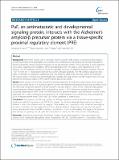| dc.contributor.author | Lahiri, Debomoy K | |
| dc.contributor.author | Maloney, Bryan | |
| dc.contributor.author | Rogers, Jack Timothy | |
| dc.contributor.author | Ge, Yuan-Wen | |
| dc.date.accessioned | 2013-05-13T19:02:03Z | |
| dc.date.issued | 2013 | |
| dc.identifier.citation | Lahiri, Debomoy K., Bryan Maloney, Jack T. Rogers, and Yuan-Wen Ge. 2013. PuF, an antimetastatic and developmental signaling protein, interacts with the Alzheimer’s amyloid-β precursor protein via a tissue-specific proximal regulatory element (PRE). BMC Genomics 14:68. | en_US |
| dc.identifier.issn | 1471-2164 | en_US |
| dc.identifier.uri | http://nrs.harvard.edu/urn-3:HUL.InstRepos:10622927 | |
| dc.description.abstract | Background: Alzheimer’s disease (AD) is intimately tied to amyloid-β (Aβ) peptide. Extraneuronal brain plaques consisting primarily of Aβ aggregates are a hallmark of AD. Intraneuronal Aβ subunits are strongly implicated in disease progression. Protein sequence mutations of the Aβ precursor protein (APP) account for a small proportion of AD cases, suggesting that regulation of the associated gene (APP) may play a more important role in AD etiology. The APP promoter possesses a novel 30 nucleotide sequence, or “proximal regulatory element” (PRE), at −76/−47, from the +1 transcription start site that confers cell type specificity. This PRE contains sequences that make it vulnerable to epigenetic modification and may present a viable target for drug studies. We examined PRE-nuclear protein interaction by gel electrophoretic mobility shift assay (EMSA) and PRE mutant EMSA. This was followed by functional studies of PRE mutant/reporter gene fusion clones. Results: EMSA probed with the PRE showed DNA-protein interaction in multiple nuclear extracts and in human brain tissue nuclear extract in a tissue-type specific manner. We identified transcription factors that are likely to bind the PRE, using competition gel shift and gel supershift: Activator protein 2 (AP2), nm23 nucleoside diphosphate kinase/metastatic inhibitory protein (PuF), and specificity protein 1 (SP1). These sites crossed a known single nucleotide polymorphism (SNP). EMSA with PRE mutants and promoter/reporter clone transfection analysis further implicated PuF in cells and extracts. Functional assays of mutant/reporter clone transfections were evaluated by ELISA of reporter protein levels. EMSA and ELISA results correlated by meta-analysis. Conclusions: We propose that PuF may regulate the APP gene promoter and that AD risk may be increased by interference with PuF regulation at the PRE. PuF is targeted by calcium/calmodulin-dependent protein kinase II inhibitor 1, which also interacts with the integrins. These proteins are connected to vital cellular and neurological functions. In addition, the transcription factor PuF is a known inhibitor of metastasis and regulates cell growth during development. Given that APP is a known cell adhesion protein and ferroxidase, this suggests biochemical links among cell signaling, the cell cycle, iron metabolism in cancer, and AD in the context of overall aging. | en_US |
| dc.language.iso | en_US | en_US |
| dc.publisher | BioMed Central | en_US |
| dc.relation.isversionof | doi:10.1186/1471-2164-14-68 | en_US |
| dc.relation.hasversion | http://www.ncbi.nlm.nih.gov/pmc/articles/PMC3582491/pdf/ | en_US |
| dash.license | LAA | |
| dc.subject | Amyloid precursor protein | en_US |
| dc.subject | Alzheimer’s disease | en_US |
| dc.subject | Cancer | en_US |
| dc.subject | Gene regulation | en_US |
| dc.subject | Gene transcription | en_US |
| dc.subject | Iron | en_US |
| dc.subject | Latency | en_US |
| dc.subject | nm23 nucleoside diphosphate kinase | en_US |
| dc.subject | Oncogenesis | en_US |
| dc.subject | PuF | en_US |
| dc.subject | SP1 | en_US |
| dc.subject | Specificity protein 1 | en_US |
| dc.subject | Transcription factor | en_US |
| dc.title | PuF, An Antimetastatic and Developmental Signaling Protein, Interacts with the Alzheimer’s Amyloid-β Precursor Protein via a Tissue-Specific Proximal Regulatory Element (PRE) | en_US |
| dc.type | Journal Article | en_US |
| dc.description.version | Version of Record | en_US |
| dc.relation.journal | BMC Genomics | en_US |
| dash.depositing.author | Rogers, Jack Timothy | |
| dc.date.available | 2013-05-13T19:02:03Z | |
| dc.identifier.doi | 10.1186/1471-2164-14-68 | * |
| dash.contributor.affiliated | Rogers, Jack | |


